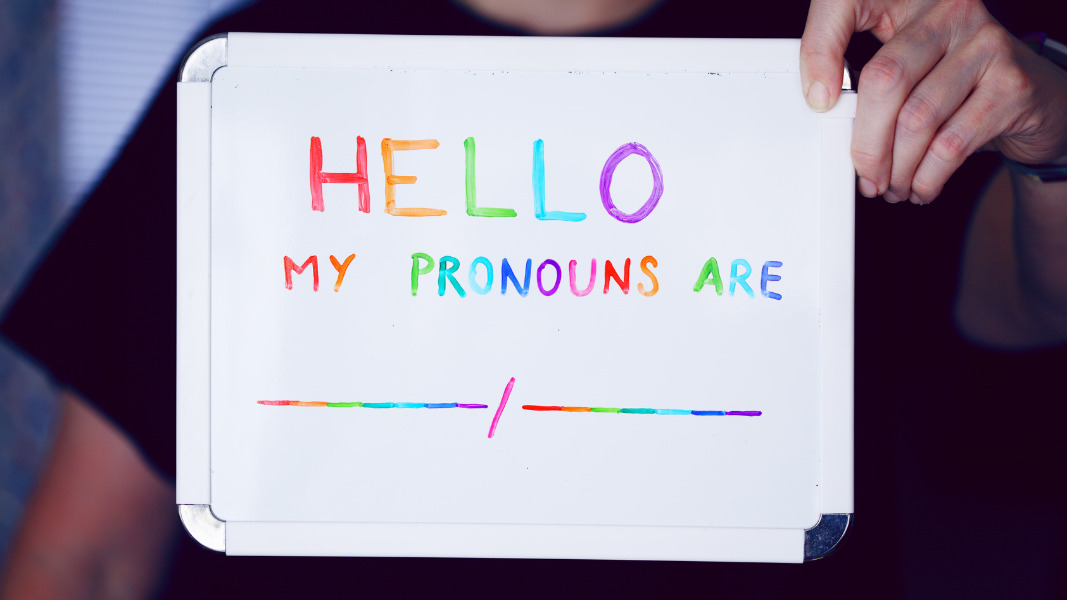Why Gender Pronouns Matter [Transcript]
Today I’m going to talk to you about why gender pronouns matter. Historically, gender identity has been determined by one’s assigned sex at birth. This was based on a binary of male or female. Recently, there has been a growing awareness and appreciation for how gender identity is an internal process in one’s development. Each individual can only truly understand it for themselves.
Society may have certain values, norms or attributes associated with gender. However, the degree that individuals fully, partially, or in no way identify with these norms can vary. As opposed to being stagnant, gender identity is fluid. Gender pronouns communicate the degree to which individuals identify with socially constructed ways of gender.
Types of Gender Pronouns
The two main categories of gender pronouns are gendered pronouns and gender neutral pronouns.
Gendered Pronouns
Gendered pronouns denote that an individual identifies with a specific gender. For example, an individual may identify as male and use he, him, and his as pronouns. Or an individual may identify as female and use she, her, and hers as pronouns.
Gender Neutral Pronouns
Gender neutral pronouns denote that an individual either identifies with neither gender (male or female). Individuals who use gender neutral pronouns may experience moving between genders. They may feel that neither one category fully encapsulates their gender identity. Gender neutral pronouns are they, them, and theirs. These pronouns may be used by individuals identifying as gender nonconforming, gender non-binary or gender fluid.
Read more about gender identity.
Misgendering
Misgendering occurs when an individual intentionally or unintentionally refers to, addresses or uses language that does not align with a person’s affirmed gender identity. Using gendered pronouns to refer to an individual who uses gender neutral pronouns is a form of misgendering. Another form of misgendering is using incorrect gender pronouns. New York and California have strict laws prohibiting misgendering in the workplace. Regardless of intention, misgendering is harmful. It can contribute to feelings of stigmatization, lack of acceptance, and a sense of exclusivity.
How to avoid misgendering
Avoid Assumptions
There are many different ways to avoid misgendering. One of the best ways is to avoid assumptions. Try not to rely on your own beliefs or perceptions as to how another individual identifies.
Ask for an individual’s pronouns
Ask an individual, “what are your gender pronouns?” or “what are your preferred pronouns?” This is direct communication, which denotes both respect and awareness for different gender identities. It reiterates the message that each individual’s gender identity is personal. It is not something that can be judged or determined by others. This also ensures that you are using the proper gender pronouns moving forward.
State your own pronouns
Introducing yourself and stating your own gender pronouns when meeting new people is another way to avoid misgendering. This also establishes an expectation and comfort for all individuals to state and confirm their own gender pronouns.
Avoid using passive language.
Saying, “X identifies as a woman” or “X prefers she, her, and hers pronouns” are forms of passive language. Instead, you can say, “X is a woman” or “X’s pronouns are she, her, and hers.” Using active and affirming language communicates recognition and acceptance of another person’s gender identity. It removes the opportunity for a person’s gender identity to be externally contested, debated or perceived as otherwise.
Engage in conversation
Engage in conversations with others about the importance of gender pronouns. Communicate that being aware of different gender identities and different modes of gender expression is a value that is important to you.
How to resolve instances of misgendering
Misgendering can be intentional or unintentional. The way one goes about resolving instances of misgendering is be a powerful opportunity. One can communicate acceptance, awareness and recognition of one’s actions moving forward.
Avoid defensiveness
The most important part of resolving instances of misgendering is to avoid defensiveness. Making excuses or rationalizing your actions only compounds feelings of discomfort. It fails to acknowledge the issue at hand. The reasons or circumstances that led to the behavior are irrelevant. What is most important is focusing on the feelings of the individual versus your own.
Defenses also impose judgment instead of acceptance. Someone’s gender identity may or may not be informed by certain gendered aesthetics or gendered constructs. However, it is not up to you to decide or determine how each person chooses to express themselves.
Seek out the person and apologize
If you’re aware that you’ve misgendered an individual, first seek out that person. You can then apologize for your actions, establish clarity and communicate that you’ll be more mindful moving forward.
Alternatively, if you are made aware by a third party, first thank them for bringing this to your attention. You can then seek out the individual whom you’ve misgendered, apologize for your actions and communicate that you’ll be more mindful moving forward.
Or if you are made aware by the individual themselves, first thank them for bringing this to your attention. You can then apologize for your actions and express an earnest message that you will do better moving forward.
Thank the individual
Thanking the individual for bringing this to your attention immediately establishes a comfortable and safe environment. The individual does not feel challenged, questioned or judged. It validates misgendering as something that is unacceptable. It also shows that you are taking ownership to improve moving forward.
When you take ownership instead of challenging, contesting or defending your actions, you are communicating a sense of respect. You are providing an opportunity to address misgendering in a respectful and validating way.
Unfortunately, this response may be unfamiliar to individuals with a history of their gender identity being challenged or questioned. Therefore, this response can be deeply meaningful for individuals who have not received this type of affirmation or validation in the past.
In conclusion, understanding an individual’s gender pronouns is extremely important. Remember to engage in conversation, ask for an individual’s pronouns, share your own pronouns and avoid passive language. Additionally, if you intentionally or unintentionally misgender an individual, avoid defensiveness, seek out the person, apologize and acknowledge that you will improve moving forward.
Want to learn more about gender identity? You may want to consider working with a LGBTQ+ affirming therapist. Click here to learn more!
How do you avoid misgendering? Leave your comments below!
- Why Gender Pronouns Matter [Video] - June 29, 2022
- How to Respond When Someone Comes Out to You [Video] - June 9, 2022
- What is Binge Eating and Why is it Hard to Stop? - December 9, 2021





